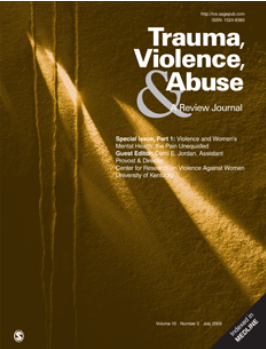非传统学术机构校园约会和性暴力的保护性和风险因素:一项范围性文献综述
IF 5.4
1区 社会学
Q1 CRIMINOLOGY & PENOLOGY
引用次数: 0
摘要
尽管对校园约会和性暴力(DSV)的风险和保护因素进行了大量研究,但在非传统机构(如少数族裔服务机构(MSIs)、社区学院或非白人为主的机构)中进行的研究很少。对非传统机构校园犯罪或受害的统计上显著的保护和风险因素的研究进行了回顾,共发表了12篇文章。该研究的纳入标准是,文章为英文,发表在同行评议的期刊上,发表于2010年至2021年之间。关键词搜索确定了校园DSV上的1160篇文章,然后对这些文章进行筛选,以确保在一个非传统的机构进行定量研究。提取了这些研究的显著加害因素、样本和机构特征以及研究设计。本综述中很少有研究调查了msi、通勤校园或社区学院的DSV。此外,研究更普遍地考察了受害、风险因素和性暴力,而不是犯罪、保护因素或约会暴力。约会暴力和性暴力的交叉因素包括酒精和药物使用、人口统计和先前的虐待。受害和犯罪的交叉因素包括个性特征、酒精和药物使用、人口统计和滥用史。未来的研究应该调查非传统机构的DSV,以增加我们对这些很少被研究的机构的风险和保护因素的理解。本文章由计算机程序翻译,如有差异,请以英文原文为准。
Protective and Risk Factors for Campus Dating and Sexual Violence at Non-Traditional Academic Institutions: A Scoping Literature Review
Despite a plethora of research examining campus dating and sexual violence (DSV) risk and protective factors, little of this research has been conducted at non-traditional institutions such as minority-serving institutions (MSIs), community colleges, or non-predominantly white institutions. A review of research on statistically significant protective and risk factors for campus perpetration or victimization at non-traditional institutions resulted in 12 articles. The inclusion criteria for the study were that the article was in English, in a peer-reviewed journal, and published between 2010 and 2021. Keyword searches identified 1,160 articles on campus DSV, which were then screened to ensure the quantitative research was conducted at a non-traditional institution. Significant perpetration and victimization factors, characteristics of the samples and institutions of these studies, and the research design were extracted. Few studies included in the review investigated DSV at MSIs, commuter campuses, or community colleges. Also, studies more commonly examined victimization, risk factors, and sexual violence, as opposed to perpetration, protective factors, or dating violence. Cross-cutting factors for both dating and sexual violence included alcohol and drug use, demographics, and prior abuse. Cross-cutting factors for both victimization and perpetration included personality characteristics, alcohol and drug use, demographics, and history of abuse. Future research should investigate DSV at non-traditional institutions to increase our understanding of risk and protective factors at these rarely studied institutions.
求助全文
通过发布文献求助,成功后即可免费获取论文全文。
去求助
来源期刊

Trauma Violence & Abuse
Multiple-
CiteScore
13.60
自引率
7.80%
发文量
131
期刊介绍:
Trauma, Violence, & Abuse is devoted to organizing, synthesizing, and expanding knowledge on all force of trauma, abuse, and violence. This peer-reviewed journal is practitioner oriented and will publish only reviews of research, conceptual or theoretical articles, and law review articles. Trauma, Violence, & Abuse is dedicated to professionals and advanced students in clinical training who work with any form of trauma, abuse, and violence. It is intended to compile knowledge that clearly affects practice, policy, and research.
 求助内容:
求助内容: 应助结果提醒方式:
应助结果提醒方式:


